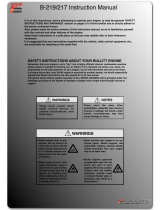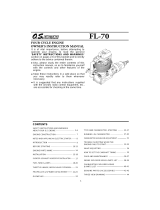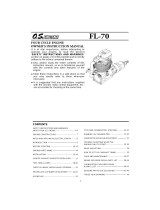Page is loading ...

MAX-18TZ SERIES
OWNER'S INSTRUCTION MANUAL
It is of vital importance, before attempting to
operate your engine, to read the general
'SAFETY INSTRUCTIONS AND WARNINGS'
section on pages 2-5 of this booklet and to strictly
adhere to the advice contained therein.
Also, please study the entire contents of this
instruction manual, so as to familiarize yourself
with the controls and other features of the
engine.
Keep these instructions in a safe place so that
you may readily refer to them whenever
necessary.
It is suggested that any instructions supplied
with the vehicle, radio control equipment, etc.,
are accessible for checking at the same time.

SAFETY INSTRUCTIONS AND
WARNINGS ABOUT YOUR
O.S.
ENGINE.........
2-5
ENGINE CONSTRUCTION, NOTES WHEN
APPLYING AN ELECTRIC STARTER................. 6-7
18TZ
SERIES
INSTRUCTION........................................
8
TOOLS, ACCESSORIES, etc ............................................. 9-10
BASIC ENGINE PARTS, CARBURETOR
CONTROLS (11K), (11L)............................ 11-13
GLOWPLUG, INSTALLATION,
NOTES
CONCERNING THE RECOIL STARTER
.................. 14-16
PRESSURIZED FUEL SYSTEM,
STARTING THE ENGINE & RUNNING-IN
('Breaking-in')...................................................17-20
FINAL ADJUSTMENT,
CARBURETOR CLEANLINESS.......................... 21-23
CONTENTS
CARE AND MAINTENANCE,
CHECKING THE ENGINE................................. 24-25
TROUBLE SHOOTING.............................. 26-29
ENGINES EXPLODED VIEW &
PARTS LIST .............................................
30-37
CARBURETOR EXPLODED VIEW &
PARTS
LIST.............
...................................
38-41
O.S. GENUINE
PARTS
&
ACCESSORIES.............. 42-43
THREE VIEW DRAWING,
MEMO
.......................................................
44-48
GUARANTEED TO KEEP YOUR
R/C CAR RUNNING WELL..............................49-52
LIMITED WARRANTY................................. 53-54
1

SAFETY INSTRUCTIONS AND WARNINGS ABOUTYOUR O.S. ENGINE
Remember that your engine is not a "toy", but a highly efficient internal-
combustion machine whose power is capable of harming you, or others, if it is
misused.
As owner, you, alone, are responsible for the safe operation of your engine, so act
with discretion and care at all times.
If at some future date, your O.S. engine is acquired by another person, we would
respectfully request that these instructions are also passed on to its new owner.
The advice which follows applies basically to ALL MODEL ENGINES and is
grouped under two headings according to the degree of damage or danger
which might arise through misuse or neglect.
WARNINGS
These cover events which
might involve serious (in
extreme circumstances, even
fatal) injury.
NOTES
These cover the many other
possibilities, generally less obvious
sources of danger, but which, under
certain circumstances, may also
cause damage or injury.
2

WARNINGS
Model engine fuel is poi-
sonous. Do not allow it to
come into contact with the
eyes or mouth.Always store
it in a clearly marked con-
tainer and out of the reach
of children.
Model engine fuel is also
highly flammable. Keep it
away from an open flame,
excessive heat, sources of
sparks, or anything else
which might ignite it. Do not
smoke or allow anyone else
to smoke, near to it.
Never operate your engine in an en-
closed space. Model engines, like
automobile engines, exhaust deadly
carbon-monoxide. Run your engine
only in an open area.
Model engines generate
considerable heat. Do not
touch any part of your
engine until it has cooled.
Contact with the muffler
(silencer), cylinder head
or exhaust header pipe, in
particular, may result in a
serious burn.
3

NOTES
This engine is intended for model cars.
Do not attempt to use it for any other
purpose.
Mount the engine in your model
securely, following the manufacturers'
recommendations, using appropriate
screws and locknuts.
Pit an effective silencer (muffler):
Frequent close exposure to a noisy
exhaust (especially in the case of the
more powerful highspeed engines) may
eventually impair your hearing and such
noise is also likely to cause annoyance
to others over a wide area.
The wearing of safety glasses is also
strongly recommended.
Take care that the glowplug clip or
battery leads do not come into contact
with rotating parts. Also check that the
linkage to the throttle arm is secure.
For their safety, keep all onlookers
(especially small children) well back (at
least 20 feet or 6 meters) when
preparing your model for running.
Before starting the engine, always check
the tightness of all the screws and nuts
especially those of joint and movable
parts such as throttle arm. Missing
retightening the loose screws and nuts
often causes the parts breakage that is
capable of harming you.
4

NOTES
To stop the engine, fully retard the
throttle stick and trim lever on the trans-
mitter, or, in an emergency, cut off the
fuel supply by pinching the fuel delivery
line from the tank.
Do not attempt to disassemble the recoil
starter of the 18TZ-TX. If you do so, the
very strong spring inside will be suddenly
ejected. This can be very dangerous.
Do not extend the starter cord more than
40cm (16"). Do not abruptly release the
operating handle. Allow the cord to
rewind smoothly while still holding the
handle.
Pull the operating handle straight out
when starting the engine, so that the cord
does not rub against the vehicle body or
engine. This will help prevent the cord
from being damaged by abrasion or
engine heat.
Warning! Immediately after a glowplug-
ignition engine has been run and is still
warm, conditions sometimes exist
whereby it is just possible for the engine to
abruptly restart if it is rotated over
compression WITHOUT the glowplug
battery being reconnected.
5

ENGINE CONSTRUCTION
With this engine, the piston
will
feel tight at the top of its stroke
(TDC) when the engine is cold.
This is normal. The cylinder bore
has a slight taper. The piston
and cylinder are designed to
achieve a perfect running
clearance when they reach
operating temperature.
When the engine is cold. When the engine is hot.
Piston
Cylinder Liner
Crankshaft
Slight taper
6

NOTES WHEN APPLYING
AN ELECTRIC STARTER
Do not over-prime. This could
cause a hydraulic lock and damage
the engine on application of the
electric starter.
If over-primed, remove glowplug,
close needle-valve and apply
starter to pump out surplus fuel.
Cover the head with a rag to
prevent pumped out fuel coming
into your eyes.
NOTE
As delivered, the engine has the
carburetor lightly fit into its intake.
Secure it changing its angle
according to the car chassis.
7

MAX-18TZ SERIES
INSTRUCTIONS
This manual handles the following four versions.
MAX- 18TZ-T with 11 L carburetor
MAX-18TZ(S)-T with 11 L carburetor
MAX-18TZ-TX with 11 L carburetor
MAX-18TZ(P)-T with 11 K carburetor
About the engine
The 18TZ series engines have been
developed for 1/10 class stadium trucks,
off-road vehicles and sport cars. All the
engine are supplied with T type P3 plug.
18TZ-TX is equipped with a newly
developed O.S. No. N1 recoil starter.
About Head Gasket
These engines are fitted with two head gaskets
of 0.1mm thick and 0.2mm thick. It is
suggested to adjust the total thickness
according to atmospheric temperature,
humidity and glowplug used.
At early stage of running-in, when a glowplug
tends to burn out early or when high
nitromethane content fuel is used, try to run
the engine as it is or removing a 0.1mm
gasket.
When low nitromethane content fuel is used,
try to run the engine removing a 0.2mm
gasket.
Standard accessories
Glow Plug P3 T-type head (Turbo head)
1 piece
(Hot Type)
Exhaust Seal Ring 1 piece
8

TOOLS, ACCESSORIES, etc.
The following items are necessary for operating the
engine.
Items necessary for starting
FUEL
Generally, it is suggested that the user selects a fuel
that is commercially available for model two-stroke
engines and contains 10-30% nitromethane. As a
starting point, we recommend a fuel containing 20%
nitromethane, changing to a fuel containing more
nitro if necessary. When the brand of fuel is
changed, or the nitro content increased, it is
advisable to repeat the running-in procedure
referred to in the RUNNING-IN paragraphs. Please
note that with high-nitro fuels,
although power may be increased
for competition purposes,
glowplug elements do not last as
long and engine life will be
shortened.
REMINDER!
Model engine fuel is poisonous.
Do
not allow it to come into contact with
the eyes or mouth. Always store it in a
clearly marked container and out of
the reach of children.
Model engine fuel is also highly
flammable. Keep it away from open
flame, excessive heat, sources of
sparks, or anything else which might
ignite it. Do not smoke or allow anyone
else to smoke, near to it.
FUEL FILTER
To installed in the fuel line between
fuel tank and carburetor to prevent
dust coming into the carburetor.
GLOWPLUG IGNITER
Commercialy available handy
glowplug heater in which the
glowplug battery and battery
leads are integrated.
9

STARTER BOX
For
starting the engine.
It is not necessary for
the recoil starter version.
7.2V BATTERIES FOR STARTER BOX
Batteries for starter box.
Select according to the
starter box used. Be sure to
full charge before using.
FUEL PUMP
For filling the fuel tank, a simple,
polyethylene "squeeze" bottle,
with a suitable spout, is required,
SILICONE FUEL LINE
Heatproof silicone tubing of
approx. 5mm o.d. and 2mm i.d.
is required for the connection
between the fuel tank and
engine.
LONG SOCKET WRENCH WITH PLUG GRIP
Recommended for easy removal and
replacement of the angled and recessed
glowplug, the O.S.Long Socket Wrench
TOOLS
HEX WRENCH
Necessary for engine installation.
1.5mm, 2mm, 2.5mm, 3mm
SCREWDRIVER
Necessary for carburetor adjustments.
No.1, No.2, etc
incorporates a special grip.
10

BASIC ENGINE PARTS
Heatsink Head
Exhaust
Crankshaft
MAX-18TZ(P)-T
Crankshaft
MAX-18TZ-TX
11
Heatsink Head
Carburetor
Type 11K
Cover Plate
Mounting Lugs
Crankcase
Starter Handle
Exhaust
Carburetor
Type 11L
Recoil Starter
Assembly No.N1
Mounting LugsRear Adaptor
Crankcase
Drive Hub

CARBURETOR CONTROLS (11K)
Needle Valve
Mixture Control Valve
Metering Needle
Throttle Stop
Screw
Thermo Insulator
Four adjustable controls are provided on
this carburetor.
The Needle-Valve:
For adjusting the mixture strength when the
throttle is fully open.
The Mixture Control Valve:
For changing the mixture strength at mid
speed and acceleration. (Do not rotate the
screw more than one turn.)
The Metering Needle:
For adjusting the mixture strength at part-
throttle and idling speeds, to obtain steady
idling and smooth acceleration to mid
speeds.
The Throttle Stop Screw:
For setting the minimum idle speed:
NOTE: Readjustment may be necessary,
occasionally to allow for changes in fuel
formula, gear ratio or clutch engagement
point.
12

CARBURETOR CONTROLS (11L)
Needle Valve
Throttle Stop
Screw
Mixture Control Valve
Thermo Insulator
Three adjustable controls are provided on
this carburetor.
The Needle-Valve:
For adjusting the mixture strength when the
throttle is fully open.
The Mixture Control Screw:
For adjusting the mixture strength at part-
throttle and idling speeds, to obtain steady
idling and smooth acceleration to mid
speeds.
The Throttle Stop Screw:
For setting the minimum idling speed:
NOTE: Readjustment may be necessary,
occasionally to allow for changes in fuel
formula, gear ratio or clutch engagement
point.
13

GLOWPLUG
Since the compatibility of glowplug and fuel
may have a marked effect on performance and
reliability, it may be worthwhile to choose the
R/C type plug found most suitable after
tests. Recommended O.S. plugs are P3 and P6.
Carefully install plug finger-tight, before final
tightening with the correct size plug wrench.
The role of the glowplug
With a glowplug engine, ignition is initiated by the
application of a 1.5-volt power source. When the
battery is disconnected, the heat retained within the
combustion chamber remains sufficient to keep the
plug filament glowing, thereby continuing to keep the
engine running. Ignition timing is 'automatic' : under
reduced load, allowing higher rpm, the plug becomes
hotter and, appropriately, fires the fuel/air charge
earlier; conversely, at reduced rpm, the plug become
cooler and ignition is retarded.
Glowplug life
Particularly in the case of very high performance
engines, glowplugs must be regarded as expendable
items. However, plug life can be extended and engine
performance maintained by careful use, i.e.:
Install a plug suitable for the engine.
Use fuel containing a moderate percentage of
nitromethane unless more is essential for racing
events.
Do not run the engine too lean and do not leave the
battery connected while adjusting the needle.
When to replace the glowplug
Apart from when actually burned out, a plug may
need to be replaced because it no longer delivers its
best performance, such as when:
Filament surface has roughened and turned white.
Filament coil has become distorted.
Foreign matter has adhered to filament or plug
body has corroded.
Engine tends to cut out when idling.
Starting qualities deteriorate.
14

INSTALLATION OF THE CARBURETOR
As delivered, the engine has its carburetor
lightly fit into the intake boss. Secure it as
follows.
1. Loosen the retainer screw, rotate the
carburetor to its correct position and make
sure that it is pressed well down into the
intake boss, compressing the rubber gasket,
before retightening screw.
2. Rotate the retainer screw gently until it
stops, then tighten a further 60-90°.
Do not overtighten the screw as this will
damage the carburetor body.
Rotate the retainer nut
gently until it stops.
ENGINE INSTALLATION
Make sure that the vehicle's engine mounting
surfaces are level and in the same plane. Poor
installation may cause distortion of the
crankcase, bearings, etc., resulting in erratic
running and loss of performance.
The recommended screws for securing the
engine are 3mm or 4-40 steel Allen hexagon
socket type.
If existing holes in the engine mount do not align
perfectly with engine mounting lugs, enlarge
them slightly with a needle-file so that screws are
in alignment with the mounting holes.
Do not allow bottom
of crankcase to
touch chassis.
Chassis
Chamfer inside edges of bearers.
Tighten a further 60-90"
15

In case of the18TZ-TX
Avoid forcing the screws. Secure with locknuts.
If the bottom of the recoil starter housing would
otherwise touch the car chassis, install the en-
gine mount spacers (optional extra) between
the engine's mounting lugs and the engine
mount. With some vehicles, it may be neces-
sary to make minor trimming modifications to
chassis or body when installing the engine.
NOTE:
When spacers are supplied joined in pairs
(see sketch) separate them as shown.
Either face may be placed downwards.
Engine Mount
Mount Spacer
(Optional Extra)
Separate
NOTES CONCERNING THE RECOIL STARTER
REMINDER! ( 18TZ-TX ONLY)
Do not attempt to disassemble the recoil starter.
If you do so, the very strong spring inside will be
suddenly ejected. This can be very dangerous.
Do not extend the starter cord more than 40cm
(16"). Do not abruptly release the operating
handle. Allow the cord to rewind smoothly while
still holding the handle.
•
•
•
•
•
•
Pull the operating handle straight out when
starting the engine, so that the cord does not
rub against the vehicle body or engine.
This will help prevent the cord from being
damaged by abrasion or engine heat.
Try to avoid spilling fuel over the starter unit and
its cord. Some fuels have a detrimental effect on
these parts.
The starter prevents the engine from being ro-
tated in the wrong direction.The unit will be
damaged if you attempt to force the flywheel in
the opposite direction (i.e. clockwise when
viewed from the crankshaft end).
16

PRESSURIZED FUEL SYSTEM
The somewhat violent changes of vehicle
attitude that occur in off-road running,
combined with the fact that, in buggy type
cars, the fuel tank is often located some
distance from the carburetor, means that
fuel 'head' at the carburettor can vary and
upset running.Therefore,it is recommended
that a muffler pressurized fuel feed system
be used.
Never run your vehicle without installing the
air cleaner. Dust and dirt that may otherwise
be drawn into the engine will rapidly shorten
its life.
Silicone tubing
Connect suitable length
of Silicone tubing between
fuel tank and silencer.
Silencer
Fuel Tank
Before starting the engine, always
check the tightness of all the screws
and nuts especially those of joint and
movable parts such as throttle arm.
Missing retightening the loose
screws and nuts often causes the
parts breakage that is capable of
harming you.
STARTING THE ENGINE &
RUNNING-IN ('Breaking-in)
The following procedure is suitable for these
engines when the O.S. T-1040 tuned silencer
and a fuel containing up to 30% nitrome-
thane are used.
Fill the tank completely with fuel.
Temporarily remove the glowplug to check
that it glows bright red when energized.
17

Element glows when energized,
Turn the needle-valve clockwise slowly until
it stops. This is the fully closed position.
Do not force to turn further.
Open the Needle-Valve
2 turns from the fully
closed position.
Close
Replace the plug when the
element does not glow or is
burnt out.
Glow Plug Igniter
In case of the 11 K carburetor
Set the throttle-stop screw so that the minimum
throttle opening (idle setting) is approximately
0.3-0.5mm.
In case of the 11 L carburetor
Set the throttle-stop screw so that the minimum
throttle opening (idle setting) is approximately
1.0mm.
Throttle Stop
Screw
approx
1mm
Note:
Throttle opening at idle should be checked
before fitting an air cleaner.
Pliers
Needle Valve
Open
18

Deliver fuel into the carburetor.
Switch
on the transmitter
and
make
sure
that
each linkage moves correctly.
Turn the engine with starter box to draw the
fuel into the engine.
Fuel tank side
Fuel
Now connect glowplug battery lead to heat
the plug filament and start the engine,
When the engine starts, first allow it to
operate in short runs at the very rich starting
settings, with the glowplug battery still
connected and the driving wheels clear of
the ground. The rich mixture will, under
these conditions, provide adequate
lubrication and cooling, indicated by profuse
smoke from the exhaust.
Attention:
It is vitally important to set
the throttle at the correct
position before starting the
engine. If the engine is
allowed to run with the throttle too far open
under "no load" conditions (i.e. with the driving
wheels not in contact with the ground) it will
rapidly over-heat and may be seriously
damaged.
Next, disconnect the glowplug battery and try
running the car on the track. If the engine
stalls, open the throttle fractionally, but try to
keep the engine running as rich as possible: if
it stops because of being excessively over-
rich, close the Needle-Valve 30° and try again.
19
/




